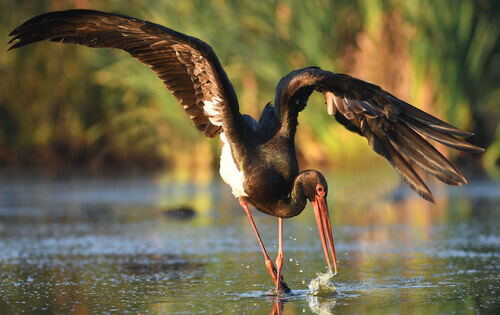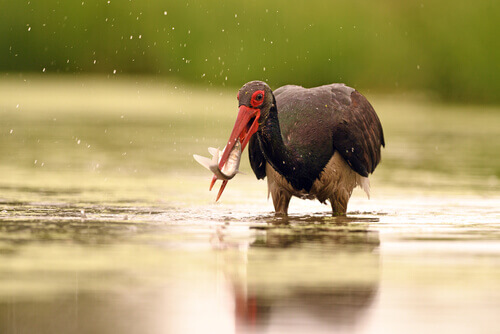The Elusive Black Stork


Written and verified by the vet Eugenio Fernández Suárez
Not as well known as its white relative, the black stork is one of the most elusive animals of the Iberian fauna. It inhabits regions of Africa, Asia, and Europe, and its appearance is very particular and recognizable. However, its shyness and scarcity play against its popularity with the public.
What’s the black stork like?
The black stork (Ciconia nigra) is a little-known wading bird. While the white stork builds its nest in bell towers and urban centers, its black relative is a very elusive bird, which makes its nests in isolated areas surrounded by forest and with nearby water bodies.
Its plumage is very peculiar, with dark tones in the upper part of its body with an iridescent plumage, which reflects green and even violet tones under the light of the sun.
The beak and legs become red with age, until they’re blood-red in the adult animal. It has white tones in the lower parts of the body, but, even in flight, the black prevails in its appearance.
Its song is also very striking, quite different from the white stork, and sounds like a meow reminiscent of certain birds of prey, such as the buzzard for example. As for its wingspan, it can easily reach 2 meters (7 ft), while its length exceeds 1 meter (3 ft) in height, and it weighs around 3 kilograms (7 lb).
Where does the black stork live?
This animal inhabits a great part of Africa, Asia and Europe —from the most Eastern European countries to Spain and Portugal. It’s a migratory bird that travels to Africa, which is normal behavior for storks.

However, there are populations that spend their winter in Spain, specifically in Doñana, Extremadura, and the Tiétar Valley. Consequently, some black storks live all year round in Spain thanks to its warmer temperatures.
On the other hand, they change their habitat depending on the season. During summer, they inhabit wooded areas and river areas with rocks, while in winter they appear in reservoirs and rice fields.
How does it behave?
The elusive black stork builds its nest with branches and moss on rocks, and reuses it every year. As for breeding, we can say that they lay two to six white eggs, which incubate for five weeks. Both parents care for the chicks, who’ll start flying when they reach two months of age.
It’s a carnivorous animal, whose main food is fish, but it also eats small mammals, reptiles, crustaceans, birds, or insects. Normally, it spends its days in areas of humid land, and inspects the terrain in search of these animals, which it hunts with its harpoon-like beak.
Like other birds, such as the white stork or the scavengers, it doesn’t dislike human garbage. Still, it’s rare to see them in landfills because of their shyness, hence they prefer to hunt their own food.

What’s its conservation status?
Regarding its threats, the main one is the human pressure on their nesting areas. This species is much more sensitive to human intervention in their habitat, and noise, hiking, or pollution stresses it out.
Forestry, river, and power line activities also put them in danger. In the Guadalquivir marshes in Spain, shots have been fired at these animals, although this isn’t very common. There are numerous conservation projects, such as the one that has been started in Extremadura, also in Spain.
It’s a bird of unknown habits, and therefore, there’s little information about its conservation status. Therefore, some consider this stork an animal in danger of extinction.
Despite all this, it’s still quite prolific. Records show that in Europe there are between 12,000 and 20,000 specimens. In Spain, there are more than 800. Meanwhile, in Denmark it’s practically extinct, and in Germany only 50 pairs remain.
This text is provided for informational purposes only and does not replace consultation with a professional. If in doubt, consult your specialist.